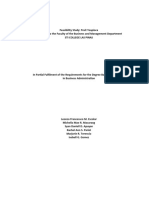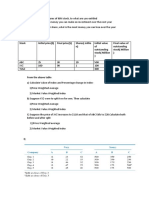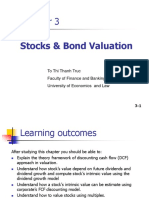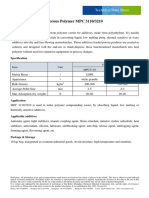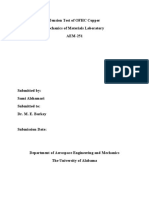Fin 550
Fin 550
Uploaded by
umamaheswara_malliCopyright:
Available Formats
Fin 550
Fin 550
Uploaded by
umamaheswara_malliCopyright
Available Formats
Share this document
Did you find this document useful?
Is this content inappropriate?
Copyright:
Available Formats
Fin 550
Fin 550
Uploaded by
umamaheswara_malliCopyright:
Available Formats
----------------------------------------------------------------------------------------Chapter 4 2) Lauren has a margin account and deposits $50,000.
Assuming the prevailing margin requirement is 40 percent, commissions are ignored, and The Gentry Shoe Corporation is selling at $35 per share: a. How many shares of Gentry Shoe can Lauren purchase using the maximum allowable margin? Prevailing Margin Requirement 40% = 40/100 = 0.4 Deposit = $50,000 Each Share Price = $35 Total Investment 50000 = 0.4x X = 50000/0.4 = $125,000 Lauren can purchase 125000/35 = 3571.42 = 3571 shares
b. What is Laurens profit (loss) if the price of Gentrys stock (1) rises to $45? On a simple math the share price went up by 10$ from earlier, we can say No of shares x 10 = 3571x10 = $35710 With share price rise from $35 to $45 Or by theory Fund = (35*3571)-50000 = $74,985 Investment = 3,571 shares x $45 = $160,695 Lauren's Profit = $160,695 - $74,985 - $50,000 = $35,710 (2) Falls to $25? On a simple math the share price loses by 10$, we can say No of shares x 10 = 3571x-10 = $-35710 Fund = (35*3571)-50000 = $74,985 Investment = 3,571 shares x $25 = $89,275 Lauren's Loss = $89,275 - $74,985 - $50,000 = ($-35,710)
c. If the maintenance margin is 30 percent, to what price can Gentry Shoe fall before Lauren will receive a margin call? Price Gentry shoe can fall before receiving a margin call = 35 * 0.6 / 0.7 = $30
Chapter 6 Question 22 At a social gathering , you meet the portfolio manager for the trust department of a local bank. He confides to you that he has been following the recommendations of the department's six analysts for an extended period and has found that two are superior, two are average, and two are clearly inferior. What would you recommend that he do to run his portfolio. The portfolio manager can trade the quantity he desires when he desires at a price not worse than the uninformed expected value. He can rely on all of the six analysts to a certain extent as long as he needs to attain, making himself sensitive to three dimensions of liquidity: price,timing, and quantity. Deviations from perfect liquidity in any of these dimensions impose shadow costs on the portfolio manager. By focusing on the trade-off between sacrificing on price and quantity instead of the canonical price-time trade-off, the model yields several novel empirical implications. Understanding a portfolio managers liquidity considerations provides important insights into the liquidity of many assets and asset classes. 2. Compute the abnormal rates of return for the five stocks in problem 1 assuming the following systematic risk measures (betas) Stock B F T C E Bi 0.95 1.25 1.45 0.70 -0.30
Stock B F T C E
Rit 11.5% 10.0 14 12 15.9
Rmt 4.0% 8.5 9.6 15.3 12.4
Bi 0.95 1.25 1.45 .70 -0.30
By using the formula AR(it) = R(it) E(R(it)) Stock B = 11.5 (4.0*.95) = 7.7% Stock F = 10.0 (8.5*1.25) = -0.625%
Stock T = 14.0 (9.6*1.45) =0.08% Stock C = 12.0 (15.3*.70) =1.29% Stock E = 15.9 (12.4*(-.30)) =19.62% The difference in abnormal rates shows how the stocks has performed. Stocks B, T, C and E performed well when compared with Stock E. Stock F performed with negative rate of return
You might also like
- CB Chapter 16Document4 pagesCB Chapter 16Sim Pei YingNo ratings yet
- FINAN204-21A - Tutorial 3 Week 3Document14 pagesFINAN204-21A - Tutorial 3 Week 3Danae YangNo ratings yet
- Fundamentals of Investing 13th Edition by Smart ISBN 013408330X Solution ManualDocument14 pagesFundamentals of Investing 13th Edition by Smart ISBN 013408330X Solution ManualbarbaraNo ratings yet
- CHAPTER 13 The Strategy of International BusinessDocument6 pagesCHAPTER 13 The Strategy of International Businessmasfiq HossainNo ratings yet
- Chapter 12 HW SolutionDocument5 pagesChapter 12 HW SolutionZarifah Fasihah67% (3)
- Past ExamDocument13 pagesPast ExamMinh TaNo ratings yet
- 5 Ch04 ProblemsDocument13 pages5 Ch04 Problemscooljani01100% (4)
- Exercises Topic 2 With AnswersDocument2 pagesExercises Topic 2 With AnswersfatehahNo ratings yet
- Chapter 9 Organizing StrategyDocument30 pagesChapter 9 Organizing Strategyjdphan100% (1)
- FIN 370 Final Exam Answers Grade - 100Document9 pagesFIN 370 Final Exam Answers Grade - 100Alegna72100% (4)
- Corporate Finance Practice ExamDocument22 pagesCorporate Finance Practice ExamNitin ArasappanNo ratings yet
- Snyder Computer Chips Inc.Document3 pagesSnyder Computer Chips Inc.Malik AsadNo ratings yet
- Case 2.1 Organizational Culture Can Help Reduce BurnoutDocument3 pagesCase 2.1 Organizational Culture Can Help Reduce Burnoutmymoonah100% (3)
- Financial Management - Risk and Return Assignment 2 - Abdullah Bin Amir - Section ADocument3 pagesFinancial Management - Risk and Return Assignment 2 - Abdullah Bin Amir - Section AAbdullah AmirNo ratings yet
- A Feasibility Study On Fruit Teapioca Chap 1 To 3Document34 pagesA Feasibility Study On Fruit Teapioca Chap 1 To 3Syan Daniell ApuyanNo ratings yet
- Three Steps To HLURB RegistrationDocument2 pagesThree Steps To HLURB RegistrationRicky Sabornay100% (1)
- FIN604 - HW04 - Farhan Zubair - 18164052Document2 pagesFIN604 - HW04 - Farhan Zubair - 18164052ZNo ratings yet
- Department of Management Sciences, National University of Modern LanguagesDocument3 pagesDepartment of Management Sciences, National University of Modern LanguagesSheiryNo ratings yet
- More Solved Examples PDFDocument16 pagesMore Solved Examples PDFrobbsNo ratings yet
- Chapter 13 HW SolutionDocument5 pagesChapter 13 HW SolutionZarifah Fasihah67% (3)
- Chapter 6 - Strategy Analysis and ChoiceDocument28 pagesChapter 6 - Strategy Analysis and ChoiceSadaqat AliNo ratings yet
- Index Computation and Holding Period Return With AnswersDocument5 pagesIndex Computation and Holding Period Return With AnswersSiddhant AggarwalNo ratings yet
- Chapter 5 Solutions 6th EditionDocument6 pagesChapter 5 Solutions 6th EditionSarah Martin Edwards50% (2)
- Trading in SecuritiesDocument16 pagesTrading in SecuritiesUmar SulemanNo ratings yet
- Answers To Practice Questions - Macroeconomics (Pre-Mid) PDFDocument5 pagesAnswers To Practice Questions - Macroeconomics (Pre-Mid) PDFDebopriyo Roy0% (1)
- Js - Camels AnalysisDocument7 pagesJs - Camels AnalysisTammy DavisNo ratings yet
- Chapter 5 - Introduction To Risk and ReturnDocument63 pagesChapter 5 - Introduction To Risk and ReturnDeok NguyenNo ratings yet
- Financial Management Test 2: Answer ALL QuestionsDocument3 pagesFinancial Management Test 2: Answer ALL Questionshemavathy50% (2)
- Chapter 3 Stocks and Bond ValuationDocument101 pagesChapter 3 Stocks and Bond ValuationYến NhiNo ratings yet
- Security Market Indicator Series - STDocument36 pagesSecurity Market Indicator Series - STEng Hams100% (1)
- Tutorial 3 Answer SegmentalDocument6 pagesTutorial 3 Answer Segmental--bolabolaNo ratings yet
- Hybrid and Derivative Securities (Lembar Jawaban)Document4 pagesHybrid and Derivative Securities (Lembar Jawaban)Radinne Fakhri Al WafaNo ratings yet
- The Foreign Exchange Market: QuestionsDocument3 pagesThe Foreign Exchange Market: QuestionsCarl Aziz100% (1)
- Chapter 5 FinanceDocument18 pagesChapter 5 FinancePia Eriksson0% (1)
- Chapter 1-The Scope of Corporate FinanceDocument13 pagesChapter 1-The Scope of Corporate Financesebseb_0480% (5)
- Initial Cash FlowDocument3 pagesInitial Cash FlowNouman Mujahid67% (3)
- 1-1 Discount Airlines Are Competing More Aggressively With Singapore Airline. How Could Singapore Airline Best Compete With Rivals?Document4 pages1-1 Discount Airlines Are Competing More Aggressively With Singapore Airline. How Could Singapore Airline Best Compete With Rivals?Afitrah ReskiNo ratings yet
- FM11 CH 09 Test BankDocument16 pagesFM11 CH 09 Test BankJohn Brian D. SorianoNo ratings yet
- Chapter 3 Solutions & NotesDocument17 pagesChapter 3 Solutions & NotesStudy PinkNo ratings yet
- Long-Term Financial Planning and Growth Chap4Document39 pagesLong-Term Financial Planning and Growth Chap4spectrum_48No ratings yet
- Financial Investment ExercisesDocument16 pagesFinancial Investment ExercisesBội Ngọc100% (1)
- Finance Chapter 9 Questions and SolutionsDocument28 pagesFinance Chapter 9 Questions and SolutionsAliAltaf75% (4)
- International Finance: Chapter 6: Government Influence On Exchange RatesDocument31 pagesInternational Finance: Chapter 6: Government Influence On Exchange RatesAizaz AliNo ratings yet
- RB Vye Ch6 SW Q&answersDocument5 pagesRB Vye Ch6 SW Q&answersAira Estalane100% (8)
- Session 4.1 Exercises With Solutions Break Even Operating and Financial LeverageDocument54 pagesSession 4.1 Exercises With Solutions Break Even Operating and Financial LeverageMargaretta LiangNo ratings yet
- Unit 10 - STMDocument3 pagesUnit 10 - STMchristine tabanaoNo ratings yet
- Financial Ratios For Chico ElectronicsDocument8 pagesFinancial Ratios For Chico ElectronicsThiago Dias DefendiNo ratings yet
- Chapter 10 Practice ProblemsDocument5 pagesChapter 10 Practice ProblemsEvelyn RoldanNo ratings yet
- IFM TB ch16Document9 pagesIFM TB ch16Faizan Ch100% (1)
- Chapter 15 HW SolutionDocument5 pagesChapter 15 HW SolutionZarifah FasihahNo ratings yet
- An Introduction To Risk and Return-History of Financial Market ReturnsDocument10 pagesAn Introduction To Risk and Return-History of Financial Market ReturnsanisaNo ratings yet
- CFF 3 Im 04Document33 pagesCFF 3 Im 04AL SeneedaNo ratings yet
- P2 November 2014 Question Paper PDFDocument20 pagesP2 November 2014 Question Paper PDFAnu MauryaNo ratings yet
- Finance Chapter No 2Document20 pagesFinance Chapter No 2UzairNo ratings yet
- Practice Question - Chaptr 4Document8 pagesPractice Question - Chaptr 4Pro Ten100% (1)
- 1 - Sample Problem Set - Decision AnalysisDocument6 pages1 - Sample Problem Set - Decision AnalysisQila Ila0% (1)
- Chapter 01 Multinational Financial Management An OverviewDocument45 pagesChapter 01 Multinational Financial Management An OverviewGunawan Adi Saputra0% (1)
- Seminar 1Document5 pagesSeminar 1EnnyNo ratings yet
- Test bank Money MarketDocument11 pagesTest bank Money MarketKarim ElmahdyNo ratings yet
- FIN 352 - Investments I Review Notes For Midterm ExamDocument4 pagesFIN 352 - Investments I Review Notes For Midterm Examsuruth242No ratings yet
- Sophie AssignmentDocument5 pagesSophie AssignmentLucky LuckyNo ratings yet
- Reading 15 Analysis of Dividends and Share Repurchases - AnswersDocument31 pagesReading 15 Analysis of Dividends and Share Repurchases - Answerstristan.riolsNo ratings yet
- Aircel Telecom LTD - Health & Safety - Employee HandbookDocument163 pagesAircel Telecom LTD - Health & Safety - Employee Handbookmohit.shahane.msNo ratings yet
- Porous Polymer MPC 3110/3210: Technical Data SheetDocument1 pagePorous Polymer MPC 3110/3210: Technical Data Sheetmanishsingh811No ratings yet
- Micros Opera Chapter III ReservationDocument109 pagesMicros Opera Chapter III ReservationJanel Castillo BalbiranNo ratings yet
- 2022 Hasan Ibacıoğlu A Multi-Disciplinary Design ApproachDocument171 pages2022 Hasan Ibacıoğlu A Multi-Disciplinary Design Approach1oliyNo ratings yet
- SudanDocument2 pagesSudanKelz YouknowmynameNo ratings yet
- BITS Pilani: Nature of Process Synthesis and AnalysisDocument19 pagesBITS Pilani: Nature of Process Synthesis and AnalysissukhmaniNo ratings yet
- Introduction To Accounting Chap 1, 12th EDDocument21 pagesIntroduction To Accounting Chap 1, 12th EDShuvo ExceptionNo ratings yet
- The Beautyful Ones Are Not Yet BornDocument25 pagesThe Beautyful Ones Are Not Yet BornOmotosho Favour100% (2)
- Tension Test of OFHC Copper CompleteDocument5 pagesTension Test of OFHC Copper CompleteUsman ishaqNo ratings yet
- SUCCESSION FULL TEXT Art 1082 and 1088 NCC PDFDocument61 pagesSUCCESSION FULL TEXT Art 1082 and 1088 NCC PDFKen LimNo ratings yet
- Godrej Presentation FinalDocument21 pagesGodrej Presentation FinalAkshay MunotNo ratings yet
- Larsen & Toubro Limited: ECC Division - EDRCDocument12 pagesLarsen & Toubro Limited: ECC Division - EDRCEngr. Nabid Rayhan KhalequeNo ratings yet
- Watch - Dogs 2 JumpChainDocument11 pagesWatch - Dogs 2 JumpChainSilva TNo ratings yet
- Kebutuhan Air Bersih Kabupaten Seruyan OkDocument13 pagesKebutuhan Air Bersih Kabupaten Seruyan OkLilis IndrianiNo ratings yet
- Contempt of CourtDocument12 pagesContempt of CourtAbhijeetMishraNo ratings yet
- 2009 - Kline & SulskyDocument11 pages2009 - Kline & SulskyMónica Hevia FredesNo ratings yet
- TEMS Investigation 24.1.1 - Release NoteDocument21 pagesTEMS Investigation 24.1.1 - Release NoteMuhammad Usman100% (1)
- Saritha - Resume - Memory LayoutDocument3 pagesSaritha - Resume - Memory Layoutkalyan100% (1)
- Managing Change CW1 and Marking Scheme - 202260Document7 pagesManaging Change CW1 and Marking Scheme - 202260Valeria MollinedoNo ratings yet
- GenmathDocument23 pagesGenmathCandia, Shyn Necole R.No ratings yet
- Project Presentation GP No 14 Transducer Sparsh RishabhJain NagaPranavDocument12 pagesProject Presentation GP No 14 Transducer Sparsh RishabhJain NagaPranavRishabh JainNo ratings yet
- Trade Test Class 1Document7 pagesTrade Test Class 1Godfrey Masumbika100% (1)
- Data Ingestion With Python Cookbook: A Practical Guide To Ingesting, Monitoring, and Identifying Errors in The Data Ingestion Process EsppenchutzDocument51 pagesData Ingestion With Python Cookbook: A Practical Guide To Ingesting, Monitoring, and Identifying Errors in The Data Ingestion Process Esppenchutzbabara.medina654100% (10)
- Scanner SPC Max MX25 System ABSDocument38 pagesScanner SPC Max MX25 System ABSvivi totorNo ratings yet
- Valvula Check PVCDocument1 pageValvula Check PVCDaniel FloresNo ratings yet
- Syllabus Fundamentals of French 101ADocument5 pagesSyllabus Fundamentals of French 101AGlauco ArneiroNo ratings yet
- Manual VWR Balances 611-3279 and - 3281Document63 pagesManual VWR Balances 611-3279 and - 3281Mohsin ahmedNo ratings yet
- English Plus Level 3 Workbook Answer Key - PDF - Perfume - OdorDocument1 pageEnglish Plus Level 3 Workbook Answer Key - PDF - Perfume - OdorRoblox Evi0% (1)














